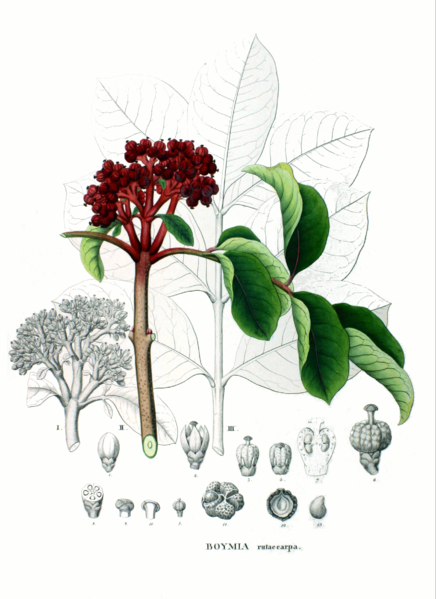 |
|
http://commons.wikimedia.org/wiki/File:Rutaceae_sp_SZ21_clean.png |
 |
|
Translate this page:
Summary
Physical Characteristics

 Euodia ruticarpa is a deciduous Tree growing to 10 m (32ft 10in). The species is hermaphrodite (has both male and female organs).
Euodia ruticarpa is a deciduous Tree growing to 10 m (32ft 10in). The species is hermaphrodite (has both male and female organs).
Suitable for: light (sandy), medium (loamy) and heavy (clay) soils. Suitable pH: mildly acid, neutral and basic (mildly alkaline) soils. It can grow in semi-shade (light woodland) or no shade. It prefers moist soil.
UK Hardiness Map
US Hardiness Map
Synonyms
Boymia rutaecarpa.
Plant Habitats
Woodland Garden Sunny Edge; Dappled Shade;
Edible Uses
References More on Edible Uses
Medicinal Uses
Plants For A Future can not take any responsibility for any adverse effects from the use of plants. Always seek advice from a professional before using a plant medicinally.
Analgesic Anodyne Anthelmintic Antiinflammatory Antitumor Antiviral Appetizer Astringent
Carminative Contraceptive Deobstruent Diuretic Miscellany Stimulant Stomachic
Wu Zhu Yu has a marked warming effect on the body, helping to relieve headaches and a wide range of digestive problems[254]. The fruit is analgesic, anthelmintic, appetizer, astringent, carminative, decongestant, deobstruent, diuretic, stimulant, stomachic and uterotonic[174, 176, 178, 218, 240]. It is used in the treatment of gastritis, nausea, headaches, oedema, beriberi and post-partum pains[147]. The partially ripe fruit is gathered in late summer and can be dried for later use[254]. The root bark is astringent and vermifuge[218]. Extracts of the plant show antiviral, antitumor and anti-inflammatory activity[218]. This species was ranked 14th in a Chinese survey of 250 potential antifertility plants[218].
References More on Medicinal Uses
The Bookshop: Edible Plant Books
Our Latest books on Perennial Plants For Food Forests and Permaculture Gardens in paperback or digital formats.

Edible Tropical Plants
Food Forest Plants for Hotter Conditions: 250+ Plants For Tropical Food Forests & Permaculture Gardens.
More

Edible Temperate Plants
Plants for Your Food Forest: 500 Plants for Temperate Food Forests & Permaculture Gardens.
More

More Books
PFAF have eight books available in paperback and digital formats. Browse the shop for more information.
Shop Now
Other Uses
References More on Other Uses
Cultivation details
We have almost no information on this species and do not know if it will be hardy in Britain, though judging by its habitat it should succeed outdoors in the milder areas of the country. It is quite possible that Tetradium ruticarpum is the correct name for this species. Judging by the needs of other members of this genus it is probably easily grown in a good loamy soil.
References Carbon Farming Information and Carbon Sequestration Information
Temperature Converter
Type a value in the Celsius field to convert the value to Fahrenheit:
Fahrenheit:
The PFAF Bookshop
Plants For A Future have a number of books available in paperback and digital form. Book titles include Edible Plants, Edible Perennials, Edible Trees,Edible Shrubs, Woodland Gardening, and Temperate Food Forest Plants. Our new book is Food Forest Plants For Hotter Conditions (Tropical and Sub-Tropical).
Shop Now
Plant Propagation
Seed - sow February in a greenhouse. Variable germination rates[78]. When they are large enough to handle, prick the seedlings out into individual pots and grow them on in the greenhouse for at least their first winter. Plant them out into their permanent positions in late spring or early summer, after the last expected frosts. Give the plants some protection from the cold for their first winter outdoors. Cuttings of half-ripe wood (preferably forced in a greenhouse), 5 - 8cm with a heel, June to August in a warm greenhouse. Fair to good percentage[78].
Other Names
If available other names are mentioned here
Native Range
TEMPERATE ASIA: China (Guangxi Zhuangzu Zizhiqu, Guizhou Sheng, Hunan Sheng, Shaanxi Sheng, Sichuan Sheng, Yunnan Sheng), Taiwan TROPICAL ASIA: Bhutan, India (Sikkim, Meghalaya), Nepal, Myanmar
Weed Potential
Right plant wrong place. We are currently updating this section.
Please note that a plant may be invasive in one area but may not in your area so it's worth checking.
Conservation Status
IUCN Red List of Threatened Plants Status :

Growth: S = slow M = medium F = fast. Soil: L = light (sandy) M = medium H = heavy (clay). pH: A = acid N = neutral B = basic (alkaline). Shade: F = full shade S = semi-shade N = no shade. Moisture: D = dry M = Moist We = wet Wa = water.
Now available:
Food Forest Plants for Mediterranean Conditions
350+ Perennial Plants For Mediterranean and Drier Food Forests and Permaculture Gardens.
[Paperback and eBook]
This is the third in Plants For A Future's series of plant guides for food forests tailored to
specific climate zones. Following volumes on temperate and tropical ecosystems, this book focuses
on species suited to Mediterranean conditions—regions with hot, dry summers and cool, wet winters,
often facing the added challenge of climate change.
Read More
Expert comment
Author
(A.Juss.)Benth.
Botanical References
146
Links / References
For a list of references used on this page please go here
Readers comment
© 2010, Plants For A Future. Plants For A Future is a charitable company limited by guarantee, registered in England and Wales. Charity No. 1057719, Company No. 3204567.